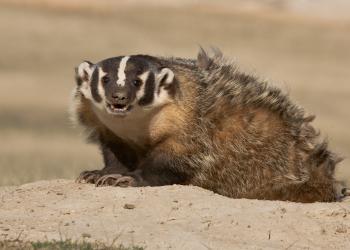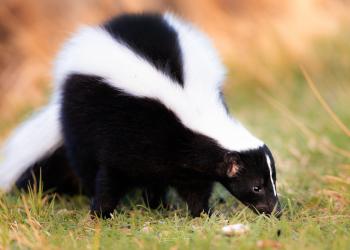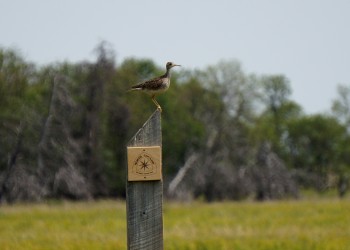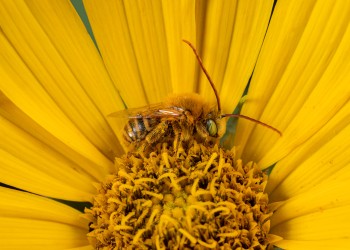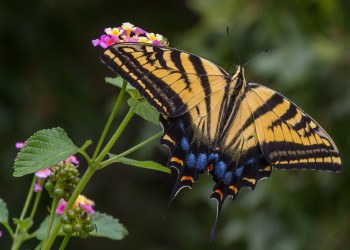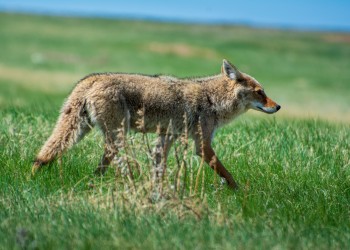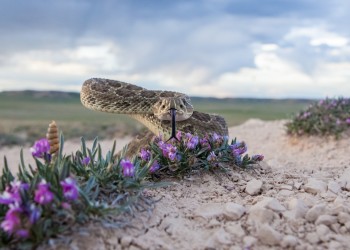Animals
The fauna of the Dakota Prairie Grasslands features a diverse ecosystem, that supports a rich variety of mammals, birds, reptiles, insects, and so much more. Here are a few examples of the various animals who call the prairie grasslands home. Before you go, visit the Animals and Plants page and download the Plant and Wildlife Checklist to help keep track of the flora and fauna you may spot in the grasslands.
Marvelous Mammals in the Grasslands
The Dakota Prairie Grasslands are home to various mammals, including herbivores like bison, elk, deer, and pronghorn, which graze on the grasses and plants. Smaller mammals like prairie dogs, voles, and other species prefer to live below the surface, thus avoiding the trampling hooves of the larger animals.
Click an image to view the photo gallery in full-screen size and read the descriptive captions.
Awesome Avians in the Grasslands
The Dakota Prairie Grasslands is home to a diverse and fascinating array of flighted fauna. Some species are perpetual prairie mainstays, while others are migratory, making the region a crucial breeding and stopover area. A few unique species are featured in the photo gallery below. A few other species are highlighted on the Birding in the Grasslands page. Also, the Grouse in the Grasslands page offers a grouse lekking photo gallery, and an article spotlighting the sharp-tailed grouse.
Click an image to view the photo gallery in full-screen size and read the descriptive captions.
Western Burrowing Owls in the Grasslands
Western Burrowing Owls are small, ground-dwelling birds well-adapted to life on open grasslands and prairies and known for their unique living arrangements and daytime activities. Note: These animals are included on the US Fish and Wildlife Service Bird of Conservation Concern list. Hunters are prohibited from shooting them.
Click an image to view the photo gallery in full-screen size and read the descriptive captions.
Writhing Reptiles in the Grasslands
Reptiles in grasslands exhibit diverse adaptations to thrive in this environment, including camouflage, basking in the sun to regulate body temperature, specialized writhing locomotion, and prey-capture features. The scaly skin of reptiles is a defining characteristic, helping them survive in various terrestrial environments. The scales are made of keratin, a protein similar to human fingernails and hair, protecting them from abrasion and dehydration. These animals are crucial in the grasslands, controlling rodent and insect populations.
Click an image to view the photo gallery in full-screen size and read the descriptive captions.
Productive Pollinators in the Grasslands
In the Dakota Prairie Grasslands, many animals help pollinate prairie wildflowers and grasses. Pollination is the process of transferring pollen, the male reproductive cells of a plant, from one part of a flower to another, usually to the stigma, to enable fertilization and seed production. Pollinators forage on flowers for pollen (protein) and nectar (carbohydrates), transferring pollen as they move between plants, thus facilitating plant reproduction. Over 100,000 animal species - including bats, bees, flies, moths, beetles, birds, and butterflies - provide free pollination services. One-third of human food comes from plants pollinated by these wild pollinators. In the photo galleries below, we highlight a few powerfully productive pollinating players.
Click an image to view the photo gallery in full-screen size and read the descriptive captions.
Bountiful Butterflies in the Grasslands
The Dakota Prairie grasslands support a variety of butterfly species. Some factors influence butterfly distribution, including the presence and availability of suitable host plants for butterfly larvae are crucial for their survival and distribution. Different butterfly species have preferences for specific prairie types, whether wet-mesic, drier, or tall-grass. The grasslands are home to diverse butterfly populations, including various species of skippers, like the Dakota and Ottoe skippers, and other common butterflies, like the cabbage white, cloudless sulphur, and Tiger Swallowtail.
Click an image to view the photo gallery in full-screen size and read the descriptive captions.
The Dakota Skipper in the Grasslands
The Dakota Skipper is a small prairie butterfly with an average one-inch wingspan and clubbed antennae. The upper side of the female’s wing is darker brown with tawny-orange spots and a few white spots on the forewing margin. The lower side is gray and brown, with a faint white spot band across the middle.
The Dakota Skipper is found in native tall-grass and mixed-grass prairie habitats, such as those in the Dakota Prairie Grasslands.
The species has experienced a population decline. In 2014, the Dakota skipper was listed as threatened under the Endangered Species Act, and critical habitats were designated in McKenzie, Ransom, Richland, and Rolette Counties in North Dakota.
Dangerous Dakota Denizens in the Grasslands
Although the grasslands are amazing, serene, scenic and stunning, all great and small creatures may still pose dangers. Visitors are encouraged to prepare and use precautions and awareness to defend themselves.
Contact the local Ranger District Office for more information.
Click an image to view the photo gallery in full-screen size and read the descriptive captions.











